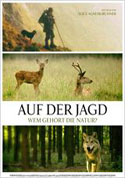

Opening 10 May 2018
Directed by:
Alice Agneskirchner
Writing credits:
Does nature belong to four- or two-legged critters? Writer-director Alice Agneskirchner takes audiences on a hunt to determine the answer. A picturesque opening sequence introduces some of the protagonists: wolves, deer, wild boar, hare, heron, and hunter. During the next 96-minuters, the trails we follow perseverate. Hunters, and Berufsjäger (professional hunters), account for the connection between land, animals, and humans amid various justifications; graphic-captions provide further information. Elk, bull moose, geese, and chamois are sighted. Naturschutz (organizations for environment/endangered species) representatives explain quotas, landmass, forestry, and more. Also spotted are: Hunters auf der jagd, at rituals, and displaying trophies—they should try using bows and arrows; a brisk detour to Canada introduces native Algonquin hunters; the Bambi effect is described. Throw in food production for humans—put people off eating pork, a commercial dairy farm tour, and, and… supporting facts and figures.
Agneskirchner dilutes her documentary with (topic) overkill without delivering a message. The Canadian Algonquin’s message is strong and unifying, so why did Agneskirchner neglect embellishing that? Puzzling, are animals getting protection as endangered species, e.g. wolves, only to be put in hunters’ crosshairs again. What is impressive, and breathtaking is Johannes Imdahl and Owen Prümm’s (animals) cinematography. André Hammesfah smoothly assembles the numerous interviews and locations, and Gert Wilden Jr.’s flattering music follows the onscreen activity, which is mostly effective.
Lacking a coherent, cohesive storyline, Auf Der Jagd drags. A direction the footage might-have-been taken, for example, is comparing the food chains importance/consequences for humans/animals from the angle pertaining to two-legged critters seizing opportunities whenever possible. Within that framework, the impact of the native peoples’ message apropos their interconnection with animals would have left audiences with food-for-thought, instead of a bundle of facts, figures and opinions. (Marinell Haegelin)